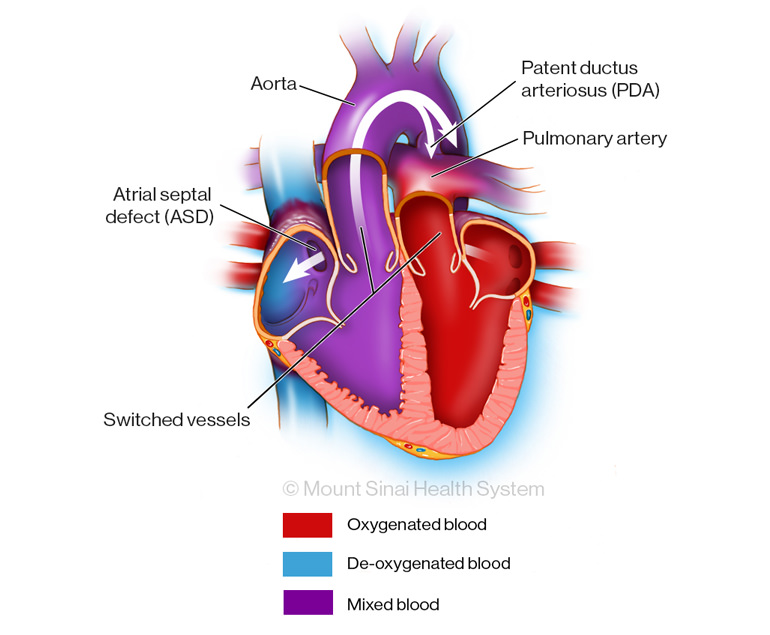
Transposition of the Great Arteries
When your baby is born with a congenital (present at birth) heart disease like transposition of the great arteries (TGA), you will likely go into overdrive to seek the best possible care. We hope to offer you some relief. At Mount Sinai Kravis Children’s Heart Center, our pediatric cardiac surgeon has the expertise to treat babies with the tiniest hearts and the most complex conditions.
About Transposition of the Great Arteries
TGA is a condition that affects the two large arteries of your baby’s heart—the main pulmonary artery and the aorta. They carry blood from the heart to the lungs and the rest of your baby’s body.

Normally, the right lower chamber (right ventricle) pumps blood into the pulmonary artery. It goes to the lungs, where the blood gets oxygen. The blood then returns to the left side of the heart. There, the left lower chamber (left ventricle) pumps blood to the body through the aorta.
In TGA, the pulmonary artery is connected to the left ventricle instead of the right ventricle. And the aorta comes from the right ventricle instead of the left. This switch, or transposition, changes how blood flows. With TGA, oxygen-poor blood pumps back into the body instead of going to the lungs. And the already oxygen-rich blood is misdirected to the lungs, where it just came from. This means that the body does not receive the oxygen and nutrients it needs.
TGA can often have other heart defects associated with it. These commonly include:
- Aortic coarctation—the aortic arch may be narrowed or obstructed
- Pulmonary valve abnormality—affecting the connection between the left ventricle and pulmonary artery
- Ventricular septal defect (VSD)—a hole between the bottom chambers of the heart
Symptoms of TGA
After your baby is born, the main symptoms are from low oxygen levels in the body, which if severe may cause your baby to appear blue, or dusky. Another symptom may be rapid breathing.
Diagnosis
TGA is often diagnosed in utero, or we may diagnose TGA within the first few hours or days of your baby’s life.
To diagnose TGA in a newborn baby, our pediatric cardiologist will perform tests, such as:
- Chest X-ray—takes pictures of the your child’s heart, lungs, and blood vessels, and can show if the heart is enlarged
- Echocardiogram (also known as an echo or cardiac ultrasound)—uses ultrasound waves to create an image of the size, shape, and movement of your child’s heart, valves, and chambers. It also shows how blood flows. It is a safe, noninvasive procedure
- Electrocardiogram (ECG or EKG)—records the electrical activity or rhythm of the heart that shows how your child’s heart is beating. It is non-invasive procedure using stickers that are placed on your child’s chest
- Pulse oximetry—monitors the oxygen content of your child’s blood without drawing blood
Treatments We Offer
To keep your baby healthy, we ensure that oxygen is flowing before our pediatric cardiac surgeon repairs the TGA. We start your baby on prostaglandin, which is a medicine that keeps open a blood vessel. This allows extra blood to flow to the lungs. It increases the mixing of oxygen rich blood with oxygen poor blood in the heart.
Our pediatric cardiac surgeon repairs the TGA using the procedures right for your child, such as:
- Balloon atrial septostomy (BAS)—If not enough mixing of oxygen rich blood and oxygen poor blood occurs in the heart, then your baby may need a BAS. This procedure uses a catheter (a thin, flexible tube) to pull a balloon across the atrial septum (wall between top chambers of the heart) to allow more oxygenated blood to be circulated throughout your baby’s body. It also gives us time to stabilize your baby before operating.
- Arterial switch operation (ASO)—During the first week or two of life, before your baby leaves the hospital, we perform this open heart procedure to restore normal blood flow through your baby’s heart and to the rest of the body. Our surgeon corrects the positions of the pulmonary artery and the aorta, and the small arteries that supply the heart with blood (the coronary arteries). If your baby has significant associated conditions, such as a VSD, or aortic coarctation, we address those conditions surgically during this operation.
Following surgery, you will need to make sure that your child stays connected to us for a lifetime of special care to maintain regular heart function and overall health.
Why Choose Children’s Heart Center?
Children’s Heart Center pediatric cardiologists are highly experienced in diagnosing, monitoring, and treating congenital heart disorders, including TGA. When we meet with you, we will explain your child’s condition and treatment. We also collaborate with your referring doctor.
We are here to take care of your child with tenderness and expertise as we offer comfort to you and your family so you can focus on your child. You can rest assured that your child is in good hands.